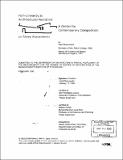| dc.contributor.advisor | Ann Pendleton-Jullian and William Porter. | en_US |
| dc.contributor.author | Rosenwald, Heidi | en_US |
| dc.contributor.other | Massachusetts Institute of Technology. Dept. of Architecture. | en_US |
| dc.date.accessioned | 2012-03-16T16:00:42Z | |
| dc.date.available | 2012-03-16T16:00:42Z | |
| dc.date.copyright | 1999 | en_US |
| dc.date.issued | 1999 | en_US |
| dc.identifier.uri | http://hdl.handle.net/1721.1/69754 | |
| dc.description | Thesis (M. Arch.)--Massachusetts Institute of Technology, Dept. of Architecture, 1999. | en_US |
| dc.description | Includes bibliographical references (p. 129-133). | en_US |
| dc.description.abstract | A thesis for architecture in three movements: I. Tempo molto moderato. (Theory.) (2767 w). II. Allegro. (Architectural Expression.) (2283 w). III. Gusto. (Final Building.) (3102 w). To see space, one needs a language. To express space, one needs a vocabulary. I have built on an existing vocabulary - one found in the writings of Faulkner - of non-linear narration. Through a series of studies I attempted to translate this literary construct into a language of spatial and experiential expression. In a dialogue with the literary, I added an architectural vocabulary by identifying existing buildings that possessed non-linear qualities. Together, this language and these vocabularies form my tools for articulating my vision. In music one can have shifting tonal centers. In literature separate points of view can create simultaneous stories. How can architecture create a multiplicity of spatial experiences and thrive from an intersection of art forms? From my studies I have abstracted two components that in dialogue lend each other greater significance. The movement through the building - necessarily sequential and physically linear - complements the experience of the spaces: non-linear and open for multiple interpretations. I attempt to express this dichotomy by setting up a tension in the architecture of anomalies to the expected. The space challenges perception and inspires in the moment of overlap (or gap) a re-thinking of the conventional and the usual. The building I will present is the Center for Contemporary Composition. Housed within one building, a multitude of programmatic activities cater to an environment of contemporary music creation and performance. It is a place for short-term residency that encourages idea exchange and intense creativity within a group of composers coming from diverse backgrounds. The building is the medium that renders new ideas in an architectural language, an evocative language derived from an external yet parallel source. | en_US |
| dc.description.statementofresponsibility | by Heidi Rosenwald. | en_US |
| dc.format.extent | 134, [1] p. | en_US |
| dc.language.iso | eng | en_US |
| dc.publisher | Massachusetts Institute of Technology | en_US |
| dc.rights | M.I.T. theses are protected by
copyright. They may be viewed from this source for any purpose, but
reproduction or distribution in any format is prohibited without written
permission. See provided URL for inquiries about permission. | en_US |
| dc.rights.uri | http://dspace.mit.edu/handle/1721.1/7582 | en_US |
| dc.subject | Architecture. | en_US |
| dc.title | Non-linearity as architectural narrative : a center for contemporary composition in three movements | en_US |
| dc.type | Thesis | en_US |
| dc.description.degree | M.Arch. | en_US |
| dc.contributor.department | Massachusetts Institute of Technology. Department of Architecture | |
| dc.identifier.oclc | 42618907 | en_US |
